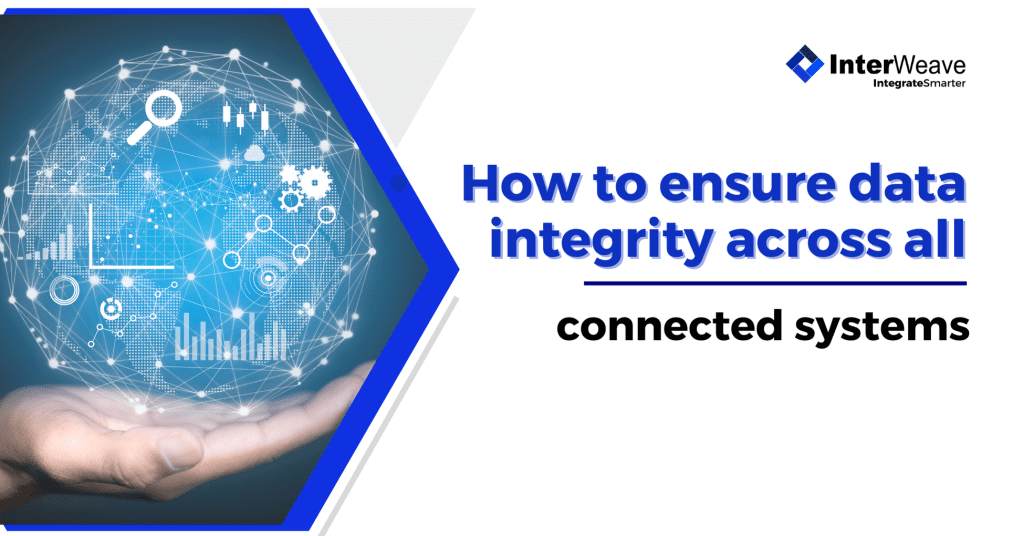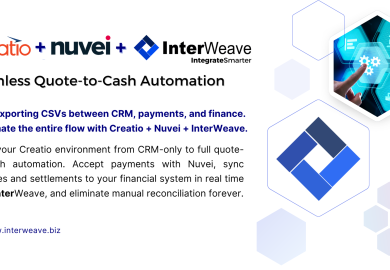- SOLUTIONS
- Industries
- Resource Center
- Support
- Company

When integrating platforms like Salesforce, QuickBooks, Sage, payment gateways, or ERP systems, one of the biggest risks is data inconsistency—leading to errors in reporting, billing, or customer communications. Ensuring data integrity is not just about syncing data; it’s about syncing it accurately, completely, and securely.
Here’s how to get it right using InterWeave SmartSolutions and general best practices.
🧩 1. Set Clear Sync Rules and Triggers
✔️ Tip: Define when and what to sync—not everything, always.
Use InterWeave’s profile logic to:
- Trigger syncs only when a record reaches a specific stage (e.g., Opportunity = Closed-Won)
- Set filters: only sync if billing address is present, or Amount > $100
- Determine data direction: one-way vs. bi-directional
🧠 Avoid data overwrite errors by setting sync ownership rules: Which system is the “source of truth” for which data?
🧬 2. Use Robust Field Mapping
✔️ Tip: Match field types, formats, and constraints exactly between systems.
In InterWeave:
- Use the drag-and-drop mapper to link source and target fields
- Apply transformation rules:
- Convert date formats (MM/DD/YYYY → YYYY-MM-DD)
- Normalize address or phone formats
- Map custom fields between CRM and accounting (e.g., “Industry Type” to “Customer Class”)
🧠 Misaligned fields are a top cause of integration failures—always document mappings before syncing live.
🔍 3. Build In Validation Rules and Error Handling
✔️ Tip: Catch bad data before it enters your target system.
With InterWeave SmartSolutions, you can:
- Set required field checks (e.g., invoice won’t push unless Customer Name is filled)
- Validate against dropdown values, lookup tables, or regex
- Flag and quarantine records with missing data instead of syncing them
💡 Enable automatic notifications when a record fails validation—so your team can fix it fast.
🔁 4. Use Test Mode Before You Go Live
✔️ Tip: Validate your logic in a sandbox first—every time.
InterWeave allows you to:
- Run profiles in test/simulated mode
- Log and review what would happen in a live sync
- Test field-level transformations and sync logic without affecting production data
🧠 Think of it as your integration “staging environment.”
🧮 5. Audit, Log, and Monitor All Sync Activity
✔️ Tip: You can’t protect what you can’t see.
- InterWeave provides a real-time dashboard with:
- Sync history
- Error logs
- Success/failure counts per object
- Keep detailed audit trails for compliance and troubleshooting
- Set up alerting rules: If a sync fails X times, alert IT or pause the profile
💡 Regularly review logs to spot patterns in data mismatches or user errors.
🧠 Summary: Best Practices for Data Integrity
| Category | Action |
| 🧩 Sync Rules | Define logic, direction, filters, and source-of-truth ownership |
| 🔄 Field Mapping | Match types, apply transformations, and test custom fields |
| 🔒 Validation | Block bad data, require fields, and notify teams |
| 🧪 Testing | Use staging/test mode before live sync |
| 📊 Monitoring | Audit logs, error alerts, and reconciliation reports |
✅ With InterWeave, You Can…
- Configure no-code data integrity checks
- Set up role-based access to profiles for data governance
- Create multi-step sync workflows that validate at every stage
- Ensure compliance with audit-ready logs and secure data handling
Recent Posts
Recent Posts
- Eliminate Manual Data Entry: CRM & Financial Integration Guide (2026)
- How Creatio + Nuvei + InterWeave Deliver a 360° Quote-to-Cash and Payment Reconciliation Experience
- How to ensure data integrity across all connected systems?
- Case Study: How a nonprofit automated its donation processing via InterWeave
- How can businesses avoid vendor lock-in with smart integration platforms?





